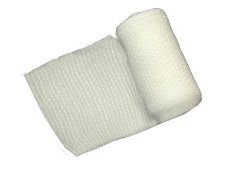Bandages are used to stop excessive bleeding and control hemorrhaging, and to keep gauze and topical medications in place. Most of the time you will want to use low to medium tension when wrapping bandages around a body part because you can cut off circulation if the wrap is too tight.
 There are times, though, when tight bandaging is used as a life-saving method to control hemorrhaging. This tight bandaging acts as a tourniquet to stop the flow of blood from an artery. You’ve probably seen make-shift emergency tourniquets used in movies. There are often scenes where somebody rips a part of a shirt and ties the fabric around an arm, stopping blood from pouring out of the brachial artery. And yes, this is a life-saving technique if arterial blood is gushing out of an arm or leg. But you don’t want to use a tourniquet if blood is not gushing. Tourniquets are a last resort because they stop all blood flow to the rest of the limb, which can kill the tissue and lead to loss of that limb. If you do find yourself in a situation where a tourniquet is called for, never leave it on for more than thirty minutes.
There are times, though, when tight bandaging is used as a life-saving method to control hemorrhaging. This tight bandaging acts as a tourniquet to stop the flow of blood from an artery. You’ve probably seen make-shift emergency tourniquets used in movies. There are often scenes where somebody rips a part of a shirt and ties the fabric around an arm, stopping blood from pouring out of the brachial artery. And yes, this is a life-saving technique if arterial blood is gushing out of an arm or leg. But you don’t want to use a tourniquet if blood is not gushing. Tourniquets are a last resort because they stop all blood flow to the rest of the limb, which can kill the tissue and lead to loss of that limb. If you do find yourself in a situation where a tourniquet is called for, never leave it on for more than thirty minutes.
There are a number of ways to bandage a wound. The best depends on what kinds of supplies you have. Here’s the general procedure.
 Place dry or medicated sterile gauze on the wound.
Place dry or medicated sterile gauze on the wound.- Wrap an elastic bandage around the appropriate body part to secure the gauze in place. Use low to medium tension when wrapping because you can cut off circulation if the wrap is too tight. If the wound is on the lower part of the leg, wrap all the way to and around the foot, as to prevent pooling of blood below the bandage.
- Secure the bandage in place with medical tape or whatever tape or fastener you have. Again, be aware of circulation.
- Watch for swelling below the bandage, and remove at once if blood seems to pool up in areas around the wrap. Also continue to feel the feet to make sure they are not getting cold. If they are, the wrap is too tight.
- If the wound was serious, see a veterinarian as soon as you can, and use the bandage as a temporary fix to stop hemorrhage.